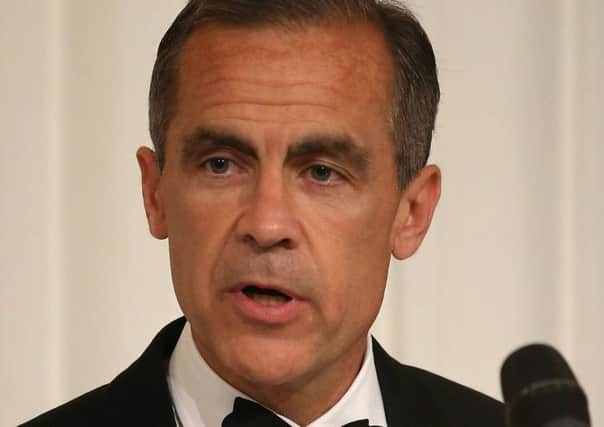Bill Jamieson: Mark Carney’s rate rise carnage


They’re here already. Barely had the news wires hummed with Bank of England Governor Mark Carney’s latest guidance that a rate rise “could happen sooner than markets currently expect” than market rates rose by ten points. This immediately raised business borrowing costs and put all lenders on alert for similar adjustments across the board. As for the pound, its effective exchange rate against a basket of currencies shot to the highest level since October 2008.
Does this point the way for a series of swift rises from the current official 0.5 per cent level? That’s unlikely. “Small and gradual” remains the consensus view.
Advertisement
Hide AdAdvertisement
Hide AdCarney’s comments were not accompanied by concerns over the housing market overheating but the overall strength of the economy, in particular the continuing fall in unemployment. But there is no sign as yet that labour market tightening is forcing up average earnings in consequence. However, the previous consensus view was that rates would not rise until the first half of next year – and this has just been blown out of the water.
Amid the wreckage is the governor’s much hailed new policy of “forward guidance”. This was launched only last August. From now on, he said, the Bank would give clear signals on the likely course of interest rates for months ahead so that businesses and home-owners could better plan their affairs.
It came with a clear statement that rates would not rise until unemployment fell to or below 7 per cent – taken at the time to mean late 2015 or the first quarter of 2016.
That was holed in February when unemployment went below 7 per cent. Guidance since has been all over the place. A briefing by Carney barely a month ago was widely interpreted to mean no rate increases before the general election in May of next year.
It is certainly “inoperable” now.
Markets since had adjusted their expectations and pencilled in a rate rise for early next year. Now Carney has warned that even this may be too sanguine. Given the strength of household spending and the upturn in business investment, a pre-Christmas rise in the official 0.5 per cent rate should not be ruled out.
Not so much “forward guidance”, then as “forward mayhem”. And the confusion has damaged Carney’s credibility.
Perhaps Carney underestimated the differences between Canada’s economy and ours – the UK’s is more open and changes in conditions more volatile. Perhaps he also had a naive faith in the accuracy of economic forecasts. Whether from the IMF, the OBR, our own Fraser of Allander Institute or the Bank itself, they have all been outpaced by the speed and strength of recovery in jobs, house prices and business investment.
Carney may have been anxious to dispel any notion of rates being raised just ahead of the Westminster general election next May. And in fairness he may also have wanted to “play safe” and be sure there was a sustainable recovery before sending clear and unambiguous signals that the era of emergency low interest rates was soon to be over. Remember that we had two false dawns after the headlong plunge of 2009. Business has not fully recovered from the deep recession and the long period of stagnation that followed. And business confidence is still brittle.
Advertisement
Hide AdAdvertisement
Hide AdNow the warning from Carney has not only sent interest rates higher but it has also driven up the pound. And that raises the hurdle for that sharp improvement in exports we need to see before we can be at all confident about a balanced and sustainable recovery.
Greater focus, I hope, will now swing back to those regular monthly meetings of the Bank’s Monetary Policy Committee. It is the MPC’s job to set the course on interest rates and the Bank’s governor to provide amplification and explanation where necessary – not the other way round.
Year of homecoming – for Scots manufacturing
COMPELLING stories of transformation marked the Scottish Manufacturing Advisory Service (SMAS) conference at Dunblane attended by some 350 business leaders last week. After decades of decline, manufacturing is enjoying a slow renaissance and a rediscovery of its contribution and importance. Major technological advances such as 3D printing are helping to bring manufacturing “back home”.
As Finance Secretary John Swinney reminded the audience, manufacturing companies in Scotland completed 185 business improvement projects last year, from tactical, short-term projects to improve productivity to transformational plans focused on a broader approach to business excellence.
Since its creation in 2006, SMAS, stewarded by Nick Shields, has delivered more than 1,050 business improvement projects contributing more than £135 million of value added benefits to Scotland’s economy.
Manager John Reid told how his Michelin plant in Dundee fought back against two threats of closure to secure survival and fresh investment. “Play for a win, not a draw” was his advice. A Michelin star for this performance.
Steven Clark spoke on the major transformational journey and culture change being undertaken by BAE Systems Naval Ships; Ken Moran of Guala Closures stressed the importance of management behaviour and equipping people to move forward; while Dennis Breugelmans told of the turnaround achieved by Wind Towers (Scotland) to being a key player in the UK renewables market supply chain.
Arguably the most inspiring contribution – and certainly the most humorous – came from Will Butler-Adams, managing director of Brompton Bicycle, who told how he and founder and investor Andrew Ritchie took this brainwave product forward from cottage industry to fast-growing international icon.
Advertisement
Hide AdAdvertisement
Hide AdThe firm’s latest innovation is being financed from a write-off “bucket fund” (actually, this is a euphemism: the term he used sounded like ‘bucket’ but is unrepeatable in a family newspaper). Expect a Scottish Enterprise “Bucket Fund” before too long? «